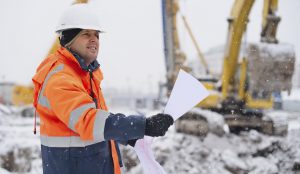
As temperatures plummet, keeping warm and safe on the jobsite becomes a concern for building site managers. ‘Cold stress’  covers injuries and illnesses that result from exposure to extreme temperatures including hypothermia, frostbite and trench foot. Making workers aware of the dangers and helping them to select the correct gear will prevent injuries.
covers injuries and illnesses that result from exposure to extreme temperatures including hypothermia, frostbite and trench foot. Making workers aware of the dangers and helping them to select the correct gear will prevent injuries.
Cold snaps in areas that don’t usually experience extreme cold are the most likely cause of cold stress injuries, but even seasoned workers in colder climates can succumb if they aren’t careful. Workers should pay attention to weather forecasts and manage outdoor work accordingly. Utilize the wind chill calculator from the National Weather Service.
Workers who have pre-existing conditions like hypertension, diabetes and hypothyroidism should be especially vigilant as these conditions can increase the risk of cold stress.
Jobsite managers must ensure that all workers are wearing appropriate gear. They must check in regularly to see if any workers are displaying symptoms of cold stress. Regular breaks in warm places should help workers to stay warm and dry. Provide radiant heaters wherever possible.
Recognizing Cold Stress Symptoms
Here is a guide from OSHA to the symptoms associated with cold stress. Should one of your crew start displaying these symptoms, call 911 immediately and seek medical attention.
Hypothermia
Normal body temperature (98.6°F) drops to 95°F or less.
- Mild Symptoms: alert but shivering.
- Moderate to Severe Symptoms: shivering stops; confusion; slurred speech; heart rate/breathing slow; loss of consciousness; death.
Frostbite
Body tissues freeze, e.g., hands and feet. Can occur at temperatures above freezing, due to wind chill. May result in amputation.
- Symptoms: numbness, reddened skin develops gray/white patches, feels firm/hard, and may blister.
Trench Foot (also known as Immersion Foot)
Non-freezing injury to the foot, caused by lengthy exposure to wet and cold environment. Can occur at air temperature as high as 60°F, if feet are constantly wet.
- Symptoms: redness, swelling, numbness, and blisters.
